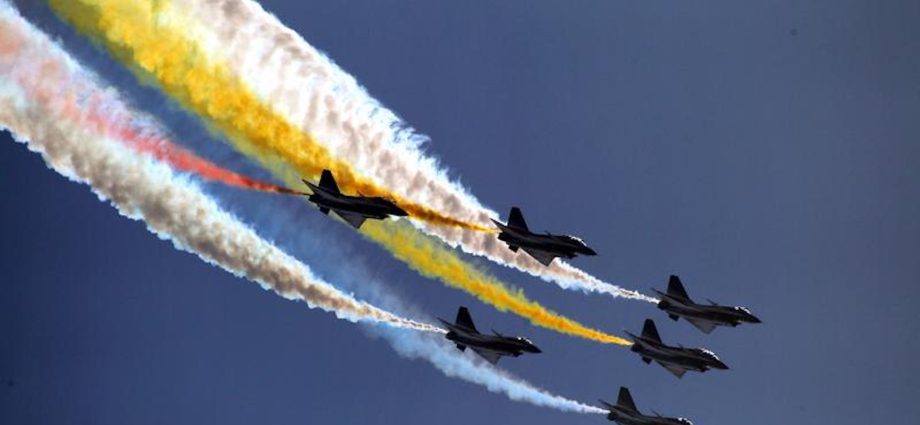The US needs to ramp up F-35 production as China and Russia steam ahead with their fifth-generation fighter programs, which increasingly threatens to open a fighter gap between the US and its near-peer adversaries.
This month, Air & Space Forces Magazine reported that the Mitchell Institute for Aerospace Studies has urged US services and the Pentagon to increase production and F-35 industrial capacity so US and allied F-35 users don’t have to wait too long for their new jet orders.
The report notes that the US Air Force initially ordered 110 F-35s per year but has gradually downscaled its orders to 80, 60, 48, or fewer.
Air & Space Forces Magazine noted that Lockheed Martin is in negotiations with the F-35 Joint Production Office (JPO) for production lots 18 and 19, which consist of 156 aircraft. Lockheed Martin has said that with additional resources it can push F-35 production above 220 aircraft annually.
However, the report also mentions that US Air Force Acquisition Chief Andrew Hunter told the Senate Armed Services Committee that Lockheed Martin would struggle to produce 156 aircraft annually, stating that the defense giant would have to increase tooling and add more shifts to its skilled workers, which have been hard to hire.
It also says that Lockheed Martin has attributed some delivery delays to worker shortages at component and material companies as they recover from the Covid-19 pandemic.
Air & Space Forces Magazine also quotes Hunter as saying that making F-35 bodies is a significant limitation, as the program initially relied on Turkey to manufacture some of the bodies. Turkey was removed from the F-35 program in 2019 due to its purchase of Russian S-400 air defense systems.

Despite the setback, in a press release this month, German defense giant Rheinmetall said it plans to open an ultramodern factory for F-35A bodies at Weeze, North Rhine-Westphalia. Rheinmetall says that production for 400 F-35A bodies will start in 2025 in cooperation with Northrop Grumman and Lockheed Martin.
Despite the massive manufacturing effort and costs going into F-35 production, the aircraft may not be the high-tech wonder weapon it is billed to be.
In a March 2023 Progressive article, Alfred Meyer claims that the F-35 is a high-maintenance plane plagued with software and jet engine troubles. Meyer says that, after flying a mission, the F-35 needs three days of maintenance and repair before it can fly again in a battle-ready and mission-capable state, unlike older planes that can fly three to five missions a day.
For example, Defense One reported in May 2023 that a December F-35 crash was caused by “harmonic resonance,” which resulted in the jet’s fuel tube fracturing. Defense One notes that a band-aid fix has been implemented as an “orifice” that reduces the impact of a loss of engine control if the fuel tube fractures due to harmonic resonance.
The report also notes that as the Pentagon continues investigating problems with the F-35’s Pratt and Whitney F135 engines, the number of US F-35s ready for duty remains below 70% for F-35As and 75% for the B and C models, with a 56% mission-capable rate this April for all types.
Meyer notes that at the end of the fiscal year 2021, the F-35 still had 800 deficiencies that needed remediation, meaning that the US and its allies are paying for the potentially faulty F-35 while struggling to keep older planes in the air. He also mentions that the F-35 has suffered multiple crashes, with one of each variant crashing in 2022.
In a January 2021 Stiftung und Wissenschaft article, Dominic Vogel stated that the F-35 might be a technology “black box” whose software and hardware are inaccessible or too complex to understand for export users.
That gives the US leverage over F-35 end users, as the latter surrender critical military capabilities and, by extension, a degree of sovereignty in exchange for a supposedly top-of-the-line fighter jet that can not be operated without US assistance.
China and Russia have also made strides in their respective fifth-generation fighter programs, putting pressure on the US to crank up F-35 production to maintain its lead.
This month, Asia Times reported that China’s J-20 stealth fighter may have flown for the first time with game-changing WS-15 engines, ditching less-reliable Russian and earlier Chinese models.
While the WS-15’s performance parameters have not been disclosed, they are most likely on par with the US Pratt & Whitney F119 engine used in the F-22 Raptor.
Moreover, Asia Times reported in February 2023 that China is using pulsed production lines to speed up J-20 production with new production techniques and improved domestic engines, pushing the number of J-20 airframes equal to or exceeding the F-22, whose production was stopped in 2011 with only 187 airframes built.
Based on J-20 serial numbers seen at the 2022 Zhuhai Air Show, China may already have up to 200 J-20s.

Defense Post reported this April that Rostec Corporation segment Ruselectronics had developed an AI-powered radio system to boost the Su-57’s resistance to reconnaissance and interference, with the new radio featuring technologies such as noise-resistant coding, improved cryptography and real-time signal processing synchronization.
That upgrade allows the Su-57 to transmit messages through different channels, increase connection stability and improve communications quality between air and ground units.
In addition, Dzen reported this month that the Su-57 had been tested with a “sixth-generation engine” that features flat nozzles, adding to the type’s supermaneuverability and stealth.
Both the J-20 and Su-57 have reportedly seen action in the South China Sea and Ukraine, with the former flying patrol missions and the latter flying suppression of enemy air defense (SEAD) missions.
To counter those developments, Asia Times noted in September 2022 that the US must maintain a production target of 72 fighters per year and keep its allies at a comparable level of capability, with a 4+1 fighter mix for the 2030s consisting of F-22s, F-35s, F-15EXs, F-16s, and A-10s.

